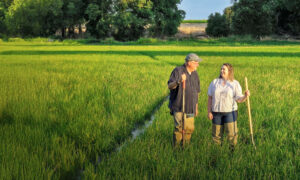This article is sponsored by Alabama-based biologicals company CHONEX. The views expressed in this guest commentary are the author’s own and do not necessarily reflect those of AgFunderNews.
For Alabama-based row crop grower Todd Stewart, the last four years have been a struggle.
Stewart has always used the recommended amounts of fertilizers, fungicides and insecticides as well as conducted regular soil sampling, which is key for understanding the condition of the ground from which crops grow.
Despite all of this, Stewart says he had years of poor crops, made worse by droughts and hurricanes.
“In the spring of 2023, I knew I had to do something different. I couldn’t spend $500-700/acre [on crop inputs] to grow corn.”
Stewart got in touch with regenerative agriculture pioneers Allen Williams and Gabe Brown’s consulting firm Understanding Ag, which in turn connected him to biologics company CHONEX.
CHONEX has for years been developing a way to restore both plant and soil health through its dry microbial concentrate StrongSoil, which aims to supercharge soil health in the face of intensive farming practices and extreme weather brought on by climate change.
Stewart applied StrongSoil to a portion of his corn and promptly saw 20 bushels more on those acres than on ones not treated.
Other growers have reported similar increases to their yields after using StrongSoil. Triple R Farmers said it saw 12 to 13 extra bushels in areas treated with StrongSoil, despite it being a drought year. Similarly, Georgia grower Sam Gray began to see a decline in blueberry plants a couple years ago, with plants not even responding to pruning last year.
Having applied StrongSoil to the plants this year, Gray says the farm has seen eight to ten inches of new growth. “Compared to previous results we would get that much growth in a year. Something has made these plants wake up, and the only thing we added is StrongSoil.”
Speeding up the impacts of regen ag
Despite the promise of regenerative agriculture, the bulk of the world’s cropland is still farmed using intensive practices that focus on yields relying on increasing amounts of synthetic and chemical inputs.
These inputs have a detrimental impact on soil biology, says CHONEX.
“Intensive, industrial farming depletes microbial populations and reduces the soil and plant functions they can support,” says CHONEX CEO and cofounder Michael Lynch. “Over time, this leads to degraded soil performance and a greater reliance on synthetic inputs until a diminishing return is realized.”
Lynch and his team created StrongSoil to address such issues.
“StrongSoil is unique because of its scope of functions for both soil and plant functionality,” notes Dr. Pam Marrone, cofounder and executive chair at the Invasive Species Corp. & Invasive Species Foundation and an advisor to CHONEX.
As an early trailblazer in the biologicals sector, Dr. Marrone has worked with hundreds of different products over the last few decades and highlights StrongSoil’s ability to shift the soil microbiome in a beneficial way.
The product works to increase organic matter as well as water-holding capacity and water infiltration in soils; it also increases nitrogen fixation and mineralization of potassium and phosphorus.
For plants, StrongSoil boosts cell strength, root functionality, nutrient uptake and tolerance to stress.

California-based agtech company Biome Makers says it noticed StrongSoil’s versatility during field trials of its BeCrop soil intelligence platform.
“Other products often demonstrate one to just a few areas of notable benefit,” says, Biome Makers senior agronomist Gus Plamann.
In addition to showing benefits across many biological metrics, the BeCrop trials with StrongSoil also showed “increases in biodiversity and resilience metrics, which take into account the entire population of the microbiome rather than assessing specific functional groups of microbes.”
“This indicates that StrongSoil can enhance soil microbial populations as a whole and increase the robustness of their populations as well as microbial diversity. Our conclusion based on these trials was that StrongSoil does not just demonstrate one or two beneficial modes of action to enhance soil biology, but can provide a versatile array of potential benefits on soil biology.”
There’s an economic boost, too, suggests Allen Williams of Understanding Ag.
Financial risk is currently one of the largest hurdles farmers wanting to adopt regenerative agriculture practices face. Currently, it’s difficult to obtain a line of credit for regen ag, as the requirements differ from those needed with a conventional agricultural loan. It can also take years for farmers to see returns on practices like no till and cover cropping.
“When implemented along with other key regenerative soil health practices, StrongSoil helps to speed up the regenerative ag process, allowing farmers to transition to regenerative agriculture with less risk,” Williams notes.
What the data says
After five years of field trials, CHONEX has finally released StrongSoil to targeted markets this year, and will also soon kick off a Series A fundraising effort.
The company says that over two growing seasons StrongSoil demonstrated an average yield increase of 15% in corn and 12% in soybeans compared to untreated cropland.
Additionally:
- StrongSoil improved soil organic matter by 8%
- Increased material biomass by 25% (in test plots)
- Reduced irrigation needs by 10%, thanks to improved water-retention capabilities in soil
- Increased carbon sequestration in StrongSoil-treated fields by 5% compared to non-treated fields
- Reduced usage of chemical fertilizers and pesticides for farmers by 20%
In terms of economic benefits, CHONEX says farmers using StrongSoil report a return on investment of three to one within the first year; input costs decreased by 15% thanks to reduced fertilizer and pesticide use.




